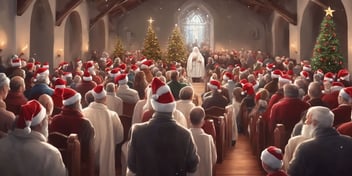- Blog
- Christmas questions
- How do different denominations within Christianity celebrate Christmas?

Christmas is the time of year when communities all around the world gear up to celebrate, spreading joy and warmth through various traditions. For Christians, this holiday holds immense significance, commemorating the birth of Jesus Christ. However, what many may not realize is that the way Christmas is celebrated can vary quite significantly among different denominations within Christianity.
From ancient rituals to contemporary customs, each group has its own unique way of honoring this sacredevent. So, let's embark on a fascinating journey through the diverse and beautiful world of Christmas celebrations within Christianity.
Overview of Christmas Celebrations
During the Christmas season, different Christian denominations come together to celebrate the birth of Jesus Christ. This festive time is marked by various traditions and customs that vary among the denominations. Catholics often attend Midnight Mass, engage in nativity scene displays, and participate in the advent calendar and wreath rituals. Protestants commonly hold candlelight services on Christmas Eve, sing carols and hymns, and may have open forums for Christmas questions from the congregation. Eastern Orthodox believers observe the Nativity Fast, celebrate Divine Liturgy on Christmas Day, and adorn their places of worship with intricate iconography and sacred art. Anglican churches conduct Nine Lessons and Carols services, and provide an Anglican Church's Christmas FAQ to address common inquiries.
Catholic Christmas Celebrations
Midnight Mass
During Midnight Mass, many Christian denominations celebrate the birth of Jesus Christ. It is a significant and cherished Christmas tradition for believers around the world. Attending the service allows individuals to reflect on the true meaning of Christmas and participate in worship and communion. Churches are often adorned with beautiful decorations and candlelight, creating a serene and reverent atmosphere. The service typically includes scripture readings, prayers, hymns, and the Eucharist. It is an opportunity for the faithful to come together as a community and express their devotion to God.
Nativity Scene and Manger Displays
Nativity scenes and manger displays are common in many Christian denominations during the Christmas season. These visual representations of the birth of Jesus serve as a reminder of the central message of Christmas. They often depict the Bethlehem stable, Joseph, Mary, the baby Jesus, and other figures like the shepherds and the wise men. Displaying a nativity scene can help believers focus on the humility and significance of Christ's birth.
Some churches even encourage individuals to set up their own nativity scenes at home as a way to reflect on the Christmas story and the meaning of Christ's coming into the world.
Advent Calendar and Wreath
The Advent Calendar and Wreath are popular Christmas traditions in many Christian denominations. The Advent Calendar is a decorative calendar with 24 windows or compartments, each representing a day leading up to Christmas. Each day, a window is opened to reveal a small surprise or treat. The Advent Wreath is a circular wreath with four candles, symbolizing the four weeks of Advent. Each Sunday, a candle is lit to represent the anticipation of Christ's birth.
These traditions help individuals and families to engage in a countdown to Christmas, fostering a sense of anticipation and reflection during the Advent season.
Protestant Christmas Celebrations
Christmas Eve Candlelight Service
Christmas Eve Candlelight services are a cherished tradition in many Protestant denominations. These services often take place on the evening of December 24th, creating a serene and reverent atmosphere as worshippers gather to celebrate the birth of Christ. During the service, the congregation sings hymns and carols, and listens to scripture readings that focus on the nativity story. The highlight of the service is the lighting of candles, symbolizing the light of Christ entering the world.
Thewarm glow of the candles creates a sense of peace and unity among the worshippers, fostering a deep spiritual connection with the Christmas story.
Carols and Hymns
Carols and hymns hold a central place in Christmas celebrations across different Christian denominations. These musical expressions not only enhance the festive atmosphere but also convey theological messages and evoke a sense of sacredness. They serve as a way to unite the congregation in worship, allowing them to reflect on the meaning of Christmas and the birth of Jesus.
Traditional carols like "Silent Night" and "O Holy Night" are frequently sung, while modern hymns such as "O Come, All Ye Faithful" are also popular. Singing together creates a communal experience and adds joyful participation to the Christmas service.
Christmas questions from the Congregation
During the Christmas season, members of various denominations often have questions related to the celebration. Common questions asked by the congregation include inquiries about the biblical origins of Christmas traditions, the significance of specific religious symbols, and the historical context behind certain customs. Pastors and religious leaders address these questions by providing biblical explanations and historical insights.
They encourage open discussions and offer opportunities for congregants to ask questions, fostering a better understanding of the religious significance of Christmas. This dialogue helps to deepen the congregation's spiritual connection and enables individuals to have a more meaningful and informed Christmas experience.
Eastern Orthodox Christmas Celebrations
Observance of the Nativity Fast
The Nativity Fast is an important observance in several Christian denominations, such as Eastern Orthodox churches. It is a period of preparation leading up to Christmas, during which believers engage in fasting and increased religious practices. This fast serves as a time of spiritual reflection and self-discipline, helping individuals to focus on the significance of Christ's birth.
Participants usually abstain from meat, dairy, and other indulgent foods while dedicating themselves to prayer, meditation, and acts of charity. The Nativity Fast cultivates a deeper spiritual connection with the Christmas story and encourages believers to prioritize faith and self-control during this festive season.
Divine Liturgy on Christmas Day
During the Divine Liturgy on Christmas Day, Eastern Orthodox churches commemorate the birth of Jesus Christ. This worship service typically includes prayers, scripture readings, and the administration of the Eucharist. The liturgy is conducted with reverence and follows a structured order. It offers believers an opportunity to come together as a community and celebrate the incarnation of Christ. Worshippers participate in the sacraments and receive spiritual nourishment.
The Divine Liturgy on Christmas Day serves as a powerful reminder of the central message of Christmas and provides a sacred space for reflection and worship.
Iconography and Sacred Art
Iconography and Sacred Art hold a significant place in the Christmas celebrations of Eastern Orthodox denominations. These visual representations play a vital role in depicting the Nativity story, as well as conveying spiritual truths. Icons, for instance, are used as windows to the divine and aid in contemplation and prayer. The portrayal of biblical figures and scenes in sacred art helps believers connect with the Christmas narrative on a deeper level.
From beautifully painted icons to intricately designed mosaics, the visual elements enrich the worship experience and serve as a powerful means of conveying the faith.
Christmas Celebrations in Anglican Churches
Nine Lessons and Carols
One popular Christmas tradition in Anglican churches is the "Nine Lessons and Carols" service. This service combines Scripture readings with carols, creating a powerful and reflective worship experience. The lessons typically highlight key events leading up to Jesus' birth, emphasizing the Christmas story's significance. Through the combination of readings and music, congregants are reminded of the biblical narrative and its relevance to the season.
The Nine Lessons and Carols service offers a structured yet engaging way to contemplate the meaning of Christmas through a blend of Scripture and song.
Anglican Church's Christmas FAQ
In the Anglican Church, Christmas questions often arise regarding various aspects of the celebration. FAQs encompass topics like the significance of Nine Lessons and Carols, a traditional service combining biblical readings and choral music. Worshippers may inquire about the order of the readings or the history behind this cherished tradition.
Additionally, common questions may revolve around the liturgical colors, symbols, or specific prayers used during Anglican Christmas services. Community members seek clarity on how to actively participate in and understand these practices. Anglican Church's Christmas FAQ strives to provide practical answers and insights to foster a meaningful and inclusive Christmas experience.
Over to you
Within Christianity, different denominations celebrate Christmas in unique ways.
For example, Roman Catholics have traditional liturgical practices such as the Midnight Mass and the Advent Wreath. Protestants, on the other hand, vary in their Christmas traditions depending on their specific church traditions. Anglicans and Episcopalians often incorporate the Festival of Nine Lessons and Carols into their celebrations, while Lutherans focus on the Advent wreath and the nativity scene. Similarly, Orthodox Christians, both Eastern and Oriental, celebrate Christmas with traditions such as the Divine Liturgy, fasting, and the Midnight Vigil. Each denomination's customs and practices reflect their distinct beliefs and traditions, resulting in diverse but meaningful celebrations of the birth of Jesus Christ.
Read On

What is the history and importance of the Christmas Eve midnight church service?
As the clock strikes midnight on Christmas Eve, churches around the world come alive with a...

How do different religions view and celebrate Christmas?
Christmas, it's that time of the year when streets dazzle with colorful lights, carolers sing...

The Beauty and Tradition of Christmas Eve Midnight Mass
As the streets grow quiet and the world settles into a peaceful slumber, there is a mystical...